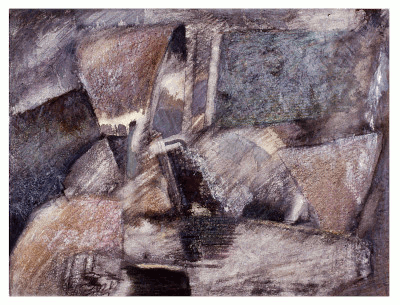 This chalk and charcoal abstract drawing on paper dates from my MFA days, and is a rare success for me in this incidental style.
This chalk and charcoal abstract drawing on paper dates from my MFA days, and is a rare success for me in this incidental style.Index:
1) Introduction
2) Art Criticism
3) Intrusive Thinking and Creativity
4) The Role of Missing Information in Creativity
5) Art and Algorithms
6) Art, A.I., and Culture
7) Autism and The World
8) YouTube Channel and Miscellaneous
Modernist Aesthetic: I admittedly credit myself with an immodest degree of uniqueness, which stems from my formative exposure to and adaptation of Modernism in art school. As a creature of this Twentieth Century aesthetic, I spent a portion of my formative youth rebelling against the ruinous tyranny Modernism became through art academia in the 1980s. By the time we get to Postmodernism, and its glib politics used to justify the lamest banality imaginable, those distant European pioneers, who inspired me to apply my imagination first and foremost, were long dead and relegated to the pages of art survey books.
Modernism is ended in its best sense, and what we are left with are self-aware parodies of its once revolutionary ideas (as found in anachronistic, factory-showroom Manhattan galleries). Today we live in an era of post-ism-ism, where everything is allowed. There are many more crafty artists than in times past, especially where artists accomplish unparalleled levels of achievement by furthering styles originated in other epochs. This unprecedented commitment to doing-one-better has given us a kind of replicable scientific algorithm.
Imagination and Its Enemies: Three ways of thinking about art creation dominate: abstract, figurative, and figurative-abstract. As someone who has dabbled in the first two, abstract art is harder to make than you realize, while figurative art is easier to make than you realize. Neither approach requires much imagination as an ingredient since the inherent structure of the art is nine tenths of the final product. Yes—some imagination is required to make tweaks to the formula, but the body of work in all three approaches is so well established that proficiency alone becomes the measure of achievement. Therefore, the lowest common denominator among proficients becomes the prevailing style.
Art movements become victims of their own success, since more artists are able to meet the proficiency test. Unless you got in on the ground floor for one of the variant offshoots in style or subject matter, then (to put it bluntly) you are merely a copyist of someone else’s hustle. A. I. art generators such as Midjourney are next generation style hustlers, and this hustle, like air brush art of the 1980s, has already reached its shelf life as of 2024.
While there may be many cooks in the kitchen, only one of several broths are available for finetuning, so what is required to succeed begins to look more like ability than imagination. This makes it easy to marginalize imagination, or damn it with faint praise.
 This chalk and charcoal abstract drawing on paper dates from my MFA days, and is a rare success for me in this incidental style.
This chalk and charcoal abstract drawing on paper dates from my MFA days, and is a rare success for me in this incidental style.
My Personal Figurative-Abstract Dilemma: There are many more artists trying their hand at abstraction than succeeding at it.
I prefer fussy-ness in all things, so the engineering aspect of abstraction, when done intelligently, holds appeal. Because of this I prefer my abstract painters straight, with no chaser.
Apart from the genius of a Francis Bacon, figurative-abstract mashups can be a tricky business. The figurative (or narrative) part of the equation is often shoehorned in; and the viewer may be disappointed to find it, like graffiti, scribbled into the margins.
This is my mature assessment of my own flirtation with abstraction from the mid-1980s through the mid-1990s. My retreat from this approach was complete once Pop Surrealism crossed my radar, and its vitality gave me permission to abandon Modernism as a relic of art school. Resultantly, I abandoned abstract experimentations before I resolved my issues with the style. (Discussion of this identity crisis is presented in my Portfolio pages.)
I became an unambiguous figurative painter around 1997, even though I continue to include minor abstract elements in my work to the present day. I would not characterize the work of my lost years (1987-1997) as figurative-abstract painting, but it is along these lines that I evaluate this history in 2024.
Owing to my detour through art school, I was trying to reconcile my love for fine art, in all its diversity, with my fertile imagination. Simultaneously, the art world had become hostile to not only figurative art by 1987, but to anyone like myself. Withdrawing from a community to which I never once professed an allegiance posed no hardship.
By 1990 I was not only disenchanted, but directionless. Comic book art ended up being easier to make, easier to store, and a better fit for my talents during this decade.
Where Figure-Abstraction does not Translate: Factors influencing my lack of success as an artist are discussed in several places throughout this website, and here is one more: Apart from Robert Williams’ parody of modern art tropes in his early low brow paintings, few Pop Surrealists stray into these dim recesses of academic formalism. They feel more comfortable with vintage commercial illustration as a starting place, and perhaps harbor some prejudice against those who have MFA degrees in painting.
The Low Brow movement was—and is—hard-core figurative. I understood this philosophy in 1998 when I first exhibited with this group of artists, and from my standpoint I was figurative, for all practical purposes. No difficulty presented itself in my mind, although, as someone with autism, I am often the last person to read the room.
It is possible that my art was quietly rejected in 2002 because of my use of “fine arts” as a framing device. Nonetheless, some Pop Surrealist works from this time show clear postmodern influences in styling, especially in the paintings of The Clayton Brothers and Camille Rose Garcia. A key difference is that figure/ground principles are less violated in their works than in mine. In-between experimentations never err in my favor in any creative pursuit, and here was no exception.
My abstraction does not function as defacement, but rather it is an integral design feature to the depicted objects themselves. These distortions are dynamical and atomic, and represent a form of picture thinking that any art school student would recognize. Defacement, where Pop Surrealists allow it, is typically seen as punk disruption, post-urban decay, or a weathering feature. Unlike my work, inclusion of these cosmetic effects should never be confused for commentary about Art Historical Canon.
The Engineer versus The Path of Least Resistance: Being autistic, it is hard to escape my scientific approach to making art. When I look a painting, in any style, it is to access how successful it is in terms of color, composition, tonal balance, execution and, lastly, concept. While the first four of these factors are apprehended visually, concept is less to do with the theory or idea behind the work of art and more to do with the inherent baggage that is pre-loaded into the style. Concept succeeds if it integrates successfully with the other factors. Concept fails if the artwork’s raison d’être is quickly seen through as gimicky, low effort work.
A young artist will work earnestly, and with exceptional craftsmanship (execution) to distinguish him or herself. This commitment is to stake their emerging reputation on a new direction. Unfortunately, as one ages, and there is less to prove should one become successful, the artist may cut corners. It sometimes feels like they only enter their studios to print money, as inferior late works begin pile up, alarmingly, at the door.
This may be the natural course of things for aging artists. And yet human nature is always testing the bondaries for tolerance: What can you get away with? Postmodernism openly champions “the death of the artist” by throwing out all standards for measurement: There is no such thing as excellence. And the art world—which is all about printing money—happily goes along with this sullying of its ages-old reputation.
Perhaps this endgame of mediocrity was always baked into Modernism, long before the term “Postmodernism” was coined.
Some New York artists openly flaunt their contempt for even simple virtues. More time is spent trying to justify a grift than the grifter spends making their grift. Saying “art should challenge the viewer” does not fly as far as it used to.
A painting should be regarded as a precious stone, where each fleck of discarded diamond, left to gather dust on the floor, is put there only to improve what remains behind on the easel.
All else is vanity.
 Robert Nava, New York Artist, is unsurpassed in the league of artistic grifters.
Robert Nava, New York Artist, is unsurpassed in the league of artistic grifters.
A Crisis of Scale in Modern Painting: When empty space is dramatically enlarged in a painting, horror vacui is a natural response to it. Most abstract painters opt for scale over finer rendering skills just to get at solutions faster. Abstract paintings generally complete faster as a result, and (unfairly) the artist may charge more for large paintings.
Scalability has been the driving force behind Modern Abstract painting. And yet, the large brushes and trowels used to create them lack personality and warmth up close. Oversized paintings often look better further away; but to create them requires the resource of a large studio space. Hence, one must be in possession of significant resources to enter this competitive field, even speculatively. This is one of the first links in a chain of self-reinforcement for a style that, without this funding, would be downgraded to just another style put on life support.
Scale gives abstract paintings the appearance of materiality. And large paintings are, after all, the prerequisite of American painters. This being true, large abstracts are rarely as involved as one finds in paintings of comparable size from the Nineteen Century, such as with Hudson River School landscapists or Albert Bierstadt. Abstracts of scale do not translate well in intimate spaces—much like a pair of inappropriate prescription lenses. Modern painting evolved to fill the corridors and lobbies of skyscrapers. Unfortunately this form-follows-function aesthetic now seem somewhat wasteful in our modular age of handheld digital devices. As skyscrapers fall into decay because the world no longer needs them, the art that decorates their walls will need to be removed to museum storage.
 Albert Bierstadt
Albert Bierstadt
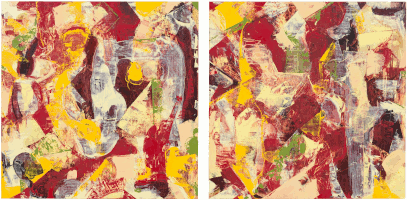 typical Gagosian Gallery painter
typical Gagosian Gallery painter
A Crisis of Value in Modern Painting: The problems of society are never as glib as critics confess to believe, namely that sexism and racism bar the emergence of new talent. Every other New York gallery exhibition, on any given day of the week, makes these complaints the centerpiece of their artists’ statements, which are often as predictable as the art itself.
Yes, there are women and people of the color who make no headway in the art world. The same may be said of most everyone else, too. The only true “ism” in the art world is classism, because wealth trumps all.
Most artists who exhibit at Gagosian or Hauser and Wirth become wealthy by proximity to wealth. The rich people who move in their circles artificially inflate the value of their art by agreeing to pay huge sums for it. Moreover, a handful of global galleries and auction houses function as middle men to launder these transactions.
It is a cartel, pure and simple. By fixing prices, the art and collector are protected from fair market forces that would otherwise drive down value of these investments. Consequently the art world is an insular community of privilege, where one finds an immodest degree of self importance and virtue signaling. It would be tragic but for the fact that you will never reach these individuals with compelling lectures about insularity. Vast swaths of private property impede your way. The rich have no notion of your existence, so are never in danger of being enlightened on any subject.
Modern Art and Its Enablers: When I was a graduate student at Indiana University working on my MFA degree in painting in 1986, Modernism was on its last legs. Basquiat was one of the last original voices to emerge from it, and his style of defacing Modern art tropes by tagging them with graffiti anticipated much of Postmodernism that followed. It slowly dawned on many within the community that every abstract and figurative-abstract cliché had been done to death by the late 1980s, and what was left as an option was to acquire a poor memory. That is, to approach each gallery opening on its own terms without reference to what came before.
With the introduction of 3-D printing and other digital assists, the conversation was modified to include feats of computer engineering. Gallery spaces became interactive science expos. One came to see insights in traditional media so rarely that it was possible not to recognize it. Gallery art, without apology, became retreads of retreaded ideas, which is not to say that the art was bad. However, when one steps through a gallery door nowadays, the art one encounters on the walls is anticipated too perfectly.
Warehouse Art and Postmodernism: Identity politics and those aforementioned advances in technology are suitable distractions in the current year, while the art itself is pushed further into the background where it serves as a prop for selfies, or provides shade for baby strollers. Unsympathetically, visual fine art has long passed its vital moment in history.
As a consequence, art expos in large airplane hangers have become a trend. One can see hundreds of gargantuan paintings in rapid succession without spending too much time standing in one place. It is, if nothing else, aerobically effective as exercise. The precise manner in how these expos come about is unknown to me, but it is doubtful that independent artists, unaffiliated with any gallery, are paying for speculative kiosks and wall space out of their own pocket.
 Much of this art would not be out of place in Pier One Imports.
Much of this art would not be out of place in Pier One Imports.
Sandwiching artists into these warehouses is a sign of the times since short-attention spans pair well to them. Artists are packed like sardines, toe-to-heel, into these spaces. It is similar in design to a smartphone screen where one can scroll through images like passing through the spray of a brief summer downpour. The brisk movement exhibited by patrons suggests that few (if any) paintings will be sold to eager collectors. A mother with a baby carriage is not a good prospect for a sale. Somehow bills are being paid for these exhibitions, but this method may resemble a Ponzi scheme if one inquires too closely.
Art Basel and Barbarians at The Gate: I recently inquired about the submission process for getting into Art Basel. It was a complicated (but misleading) process where all I managed to do was to sign up to receive spam emails. No—individual artists may not sign up to exhibit at Art Basel. They do not tell you this directly. You can only exhibit if you are represented by a first tier gallery who has a kiosk at the exhibition. Incidentally, major galleries do not publish submission criteria on their websites.
In someone’s mind, this is the way it has to be, so that the herd may be thinned, and control may be maintained over an onslaught of submissions from unknown artists. Few artists research the house styles of the galleries they approach, and this lack of homework breeds both contempt and indifference from the galleries towards submitters. There is nothing personal about these rejections from the gallery’s perspective. And yet, having no process for evaluating artists on merit leads, eventually, to a stagnacy doom loop, such as I describe.
Were it not for curators validating these grifts through high-toned museum and gallery exhibitions, no one would think it amiss to find much of this approved “art” in the dumpster out back of the building. Veneers of respectability are often pretenses, and crutches where the art cannot stand, unassisted, on its own two legs.
 A Day in Saugatuck, MI (2014)
A Day in Saugatuck, MI (2014)
The Ascendancy of Winning Formulas: Paintings these days—whether encrusted, stressed, monotoned, or saturated in bright primary color—are calibrated for effect. They are pleasant to walk by hurriedly, as if on the way to a table in a high-priced LA restaurant.
Flora Yukhnovich is a young painter who creates colorful and attractive abstract paintings. I was drawn to a video about her work because, from a thumbnail size title card and preview, her paintings resemble Baroque/Rococo paintings in color and design. One not only sees the influence of Tiepolo and other art historical painters, but actual schematics for the paintings themselves.
This is not the first time I have seen repurposed Baroque/Rococo motifs in recent years. While mapping out my first YouTube video about A. I. art, I downloaded several A. I. thumbnail examples onto my iMac. In miniature, they resembled Flora’s paintings.
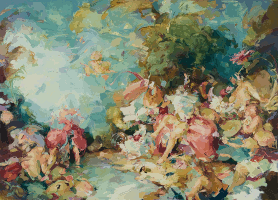 Flora Yukhvonich painting
Flora Yukhvonich painting
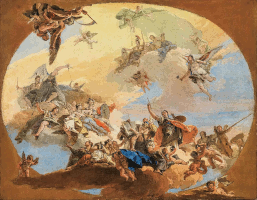 Tiepolo Baroque painting
Tiepolo Baroque painting
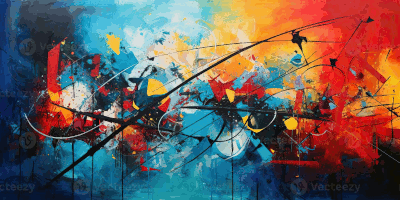 A. I. abstract painting
A. I. abstract painting
A Crisis of Contraction in Modern Painting: In recent months I have toured numerous gallery exhibitions via YouTube, which has only reinforced my impressions about what is on view. Algorithmic repetitions over the decades have supplied sure-fire refinements in studio practice, especially in abstract and abstract-figurative art.* Flora Yukhnovich is but one example.
A fair number of diligent figurative painters can still be found in first tier galleries. Jonas Wood is highly involved with his paintings, which resemble assemblages of intricate press-on decals built up as complete pictures. He is deserving of praise, as is Izzy Wood for her desaturated photo collages paintings, which put me in mind of a less kinetic version of postmodern David Salle, circa 1990.
There are other accomplished New York artists, of course, although none are so gifted as to appear out of place in any commercial gallery exhibition in any American city. The question is: why these artists, since the only thing exceptional about their paintings is the extra work they put into them?
Exploring idiosyncratic photographic sources, with various techniques, is the most common form of figurative painting. Exhibiting within a Manhattan zip code adds nothing to this formula beyond a high price tag, and the opportunity to improve as a practicing artist because one receives financial compensation for it. Any artist with raw ability and drive, working under these favorable conditions, will thrive.
To be clear, New York artists may be successful because of these privileges, but they are not famous. There are no more famous artists because there is nothing new left to say. Whether in acknowledgement of this fact, or the cause for it, first tier galleries remain unapproachable. One might call this a contraction in the market, except that the most talented artists working today are often locked out of these spaces.
(*) I might count myself among the vanguard in this trend. My figurative-abstract collage paintings (1986-1996) are in keeping with the current cluttered aesthetic one sees in high-toned galleries. Four of these paintings are featured in the foreground of the below photograph. The location is upstate New York, and the house (plus paintings) belong to friend, Tommy H. Hyndman. A few of these paintings can be seen in greater detail in my latter Portfolio pages.
Worth More Dead Than Alive: There is nothing rational or fair about the art market, although the best career move for any artist is to pass away. At this point, his or her output of work ceases; and the art world loves nothing more than scarcity.
Still, much of the high ticket art that winds up is serious collections is just god awful: poor ideas, poorly executed… The more this art leaves you feeling barren, uninspired, and soulless, the more these lucrative transactions feel like rich people paying to be publicly berated by their inferiors: first for having too much money, and then for being too ignorant to recognize better art.
Resultantly, certified quality is harder to come by these days, if only because it has been locked out of the equation. Its very existence drives down the value of all the other stuff, which is yet one more excuse to keep it out of sight. Yes, scarcity wins out in the long run, but the artist has to be dead for that truth to emerge.
YouTube’s Heat Maps and Uncomfortable Truths: While watching the aforementioned videos centering on art gallery shows, one can track other viewers’ interests by pulling up that video’s heat map. Heat maps present a visual graph showing where viewers concentrate.
Yes, strolling tree-lined streets and visiting quaint bistros receives a predictable amount of interest, but one can also gauge overall engagement with individual artist exhibitions. Those artists who receive the most heat are usually the most talented or industrious within that video.
Without fail, people are more interested in engaging art than less engaging art. Appeals for how important the less engaging art is, amount to nothing. This judgment is akin to reading insurance actuarial tables and finding out uncomfortable truths about human nature: People want to look at pretty pictures and eat Pain au Chocolat.
I have more to say on the culture of art later in my blog pages.)
Copyright © 2024-2022 michael l. teague all rights reserved.